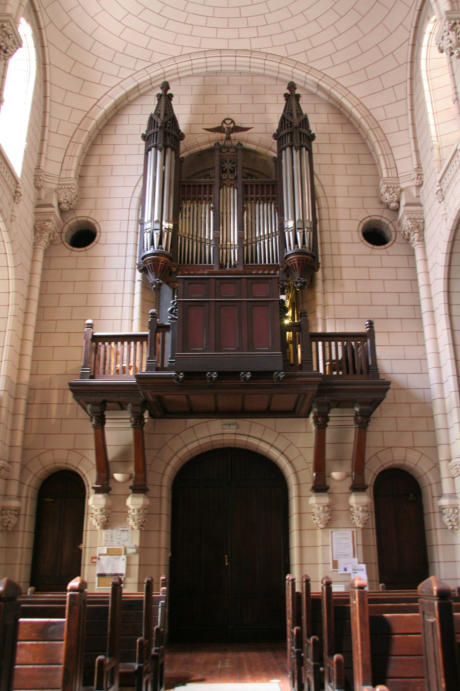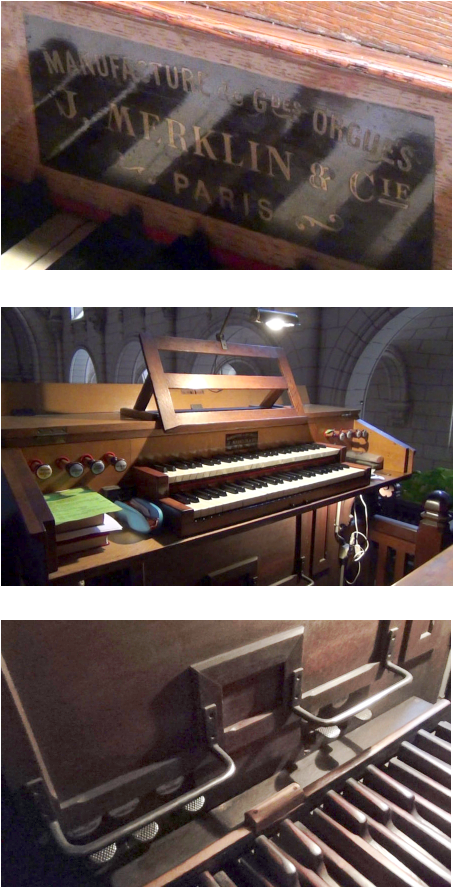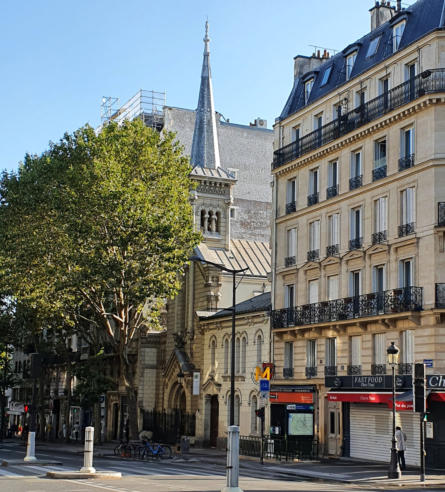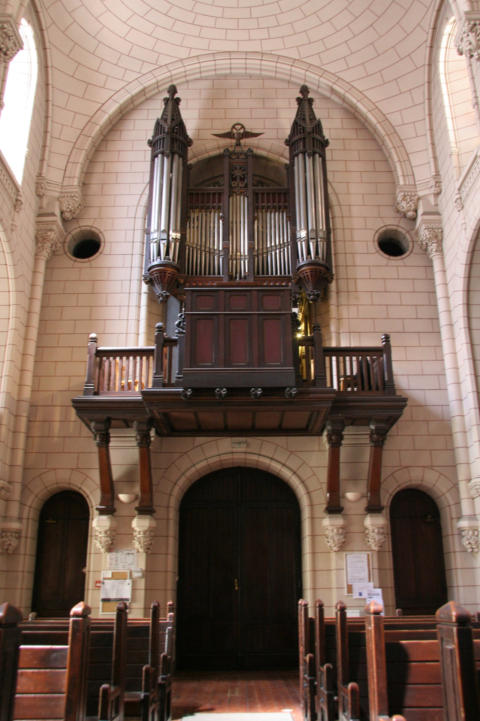




Saint-Paul-de-Montmartre was built in 1896-1897. It is
the work of Auguste Rey, an architect of Protestant
origin (to whom we also owe the Lutheran church of
BonSecours, rue Titon. in the 11th arrondissement of
Paris). The style of the church is Romano-Byzantine with
geometric and plant decorations. The façade is made of
stone and topped by a bell tower. The interior of the
church is sober and clear. The nave is composed of 4
spans opened by arches to the right and left
overlooking the grandstands and aisles.



D4
Joseph Merklin establishments sent the parish an offer
dated 18 Dec. 1897. It provided for two manual keyboards
•
Grand Orgue, 56 notes [ut-sol]: Montre, Bourdon and
Salicional of 8 feet;
•
Récit expressif, 56 notes [ut-sol]: Gamba and Voix
Cécleste of 8 feet, Flûte octaviante of 4 feet and
Bassson-Haurbois of 8 feet)
•
Pedal keyboard (30 notes [ut-fa] Soubasse of 16 feet).
The pipes of the manual stops were made of tin, those of
the pedal of wood.
The organ buffet was designed by the architect of the
church, Augustin Rey.
By 1910, the instrument had already undergone the rigors
of temperature variations: pieces of wood had cracked
and horns were occurring. To make matters worse, the
Merklin establishments no longer seriously maintained
the instrument. The organ builder was changed in 1912.
In 1926, the wind engine became electric and was
modified in 1929 to match the new frequency of electric
current.
In 1933, Georges Gutschenritter proceeded to the
complete overhaul of the organ.
In January 1977, Adrien Maciet proposed a proposal for
the restoration and enlargement of the organ. In addition
to the work of dismantling, dusting, repairing the pipes,
restoring the (then) pneumatic traction and its
transformation into direct mechanics, the composition of
the instrument had to evolve:
•
at the Grand Orgue. transformation of the Salicional 8'
into a 4' Prestant and the addition of a Doublette 2’ or
Plein Jeu;
•
to the Pedal, reconstruction of the keyboard, with the
addition of three real stops.
A "complementary project" reported in November of the
same year, states the necessary reconstruction of two new
wind chests to replace the single one, which had become
irreparable. The new composition of the instrument,
proposed by Marie-Louise Girod-Parrot became:
•
on the GO: Montre and Bourdon of 8 feet, Prestant 4'.
Doublette 2'·, Plein Jeu IV
•
on the Swell (or Positive), Cor de nuit 8', Flute 4'·,
Quarte 2'·, Nasard, Tierce, Cymbale II and Hautbois 8;
•
on the Pedal: always the Soubasse 16'.
Yves Fossaert now maintains the instrument.
In 2021, Ie Grand Orgue includes the Montre and the Bourdon
of 8' as well as the Prestant of 4'.
On the Swell, which is no longer expressive, take place Ie Cor
de nuit 8', the Flute octaviante 4', the Nasard and the Basson-
Hautbois 8' (reassembled in the 2010s). The Pedal is
unchanged. Of the six original coupling and combination
pedals, only the two pulls and the coupling of the two manual
keyboards now work.
Source: Le Paris des Orgues, Marathon des orgues 18
September 2021
1897 - Merklin (1)
1933 - Gutschenritter (5)
1977 - Maciet (3a)
II/13 - traction mécanique -
composition
Organiste titulaire
Léonard Ganvert
Concerts
-
Services with organ
Sunday, 10:30 AM
Videos
-
Photo of the organ: Jeroen de Haan
Organs of Paris

ORGANS OF PARIS © 2024 Vincent Hildebrandt ALL ORGANS
D4
Joseph Merklin establishments sent the parish an offer dated
18 Dec. 1897. It provided for two manual keyboards
•
Grand Orgue, 56 notes [ut-sol]: Montre, Bourdon and
Salicional of 8 feet;
•
Récit expressif, 56 notes [ut-sol]: Gamba and Voix Cécleste
of 8 feet, Flûte octaviante of 4 feet and Bassson-Haurbois
of 8 feet)
•
Pedal keyboard (30 notes [ut-fa] Soubasse of 16 feet).
The pipes of the manual stops were made of tin, those of the
pedal of wood.
The organ buffet was designed by the architect of the church,
Augustin Rey.
By 1910, the instrument had already undergone the rigors of
temperature variations: pieces of wood had cracked and
horns were occurring. To make matters worse, the Merklin
establishments no longer seriously maintained the
instrument. The organ builder was changed in 1912.
In 1926, the wind engine became electric and was modified
in 1929 to match the new frequency of electric current.
In 1933, Georges Gutschenritter proceeded to the complete
overhaul of the organ.
In January 1977, Adrien Maciet proposed a proposal for the
restoration and enlargement of the organ. In addition to the
work of dismantling, dusting, repairing the pipes, restoring
the (then) pneumatic traction and its transformation into
direct mechanics, the composition of the instrument had to
evolve:
•
at the Grand Orgue. transformation of the Salicional 8'
into a 4' Prestant and the addition of a Doublette 2’ or
Plein Jeu;
•
to the Pedal, reconstruction of the keyboard, with the
addition of three real stops.
A "complementary project" reported in November of the
same year, states the necessary reconstruction of two new
wind chests to replace the single one, which had become
irreparable. The new composition of the instrument,
proposed by Marie-Louise Girod-Parrot became:
•
on the GO: Montre and Bourdon of 8 feet, Prestant 4'.
Doublette 2'·, Plein Jeu IV
•
on the Swell (or Positive), Cor de nuit 8', Flute 4'·, Quarte
2'·, Nasard, Tierce, Cymbale II and Hautbois 8;
•
on the Pedal: always the Soubasse 16'.
Yves Fossaert now maintains the instrument.
In 2021, Ie Grand Orgue includes the Montre and the Bourdon of
8' as well as the Prestant of 4'.
On the Swell, which is no longer expressive, take place Ie Cor de
nuit 8', the Flute octaviante 4', the Nasard and the Basson-
Hautbois 8' (reassembled in the 2010s). The Pedal is unchanged.
Of the six original coupling and combination pedals, only the two
pulls and the coupling of the two manual keyboards now work.
Source: Le Paris des Orgues, Marathon des orgues 18 September
2021
1897 - Merklin (1)
1933 - Gutschenritter (5)
1977 - Maciet (3a)
II/13 - traction mécanique -
composition
Organiste titulaire
Léonard Ganvert
Concerts
-
Services with organ
Sunday, 10:30 AM
Videos
-
Photo of the organ: Jeroen de Haan





















